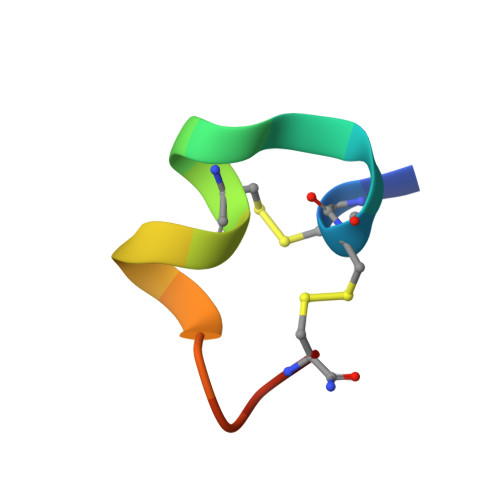Achbp-Targeted Alpha-Conotoxin Correlates Distinct Binding Orientations with Nachr Subtype Selectivity
Dutertre, S., Ulens, C., Buttner, R., Fish, A., Van Elk, R., Kendel, Y., Hopping, G., Alewood, P.F., Schroeder, C., Nicke, A., Smit, A.B., Sixma, T.K., Lewis, R.J.(2007) EMBO J 26: 3858
- PubMed: 17660751
- DOI: https://doi.org/10.1038/sj.emboj.7601785
- Primary Citation of Related Structures:
2UZ6 - PubMed Abstract:
Neuronal nAChRs are a diverse family of pentameric ion channels with wide distribution throughout cells of the nervous and immune systems. However, the role of specific subtypes in normal and pathological states remains poorly understood due to the lack of selective probes. Here, we used a binding assay based on acetylcholine-binding protein (AChBP), a homolog of the nicotinic acetylcholine ligand-binding domain, to discover a novel alpha-conotoxin (alpha-TxIA) in the venom of Conus textile. Alpha-TxIA bound with high affinity to AChBPs from different species and selectively targeted the alpha(3)beta(2) nAChR subtype. A co-crystal structure of Ac-AChBP with the enhanced potency analog TxIA(A10L), revealed a 20 degrees backbone tilt compared to other AChBP-conotoxin complexes. This reorientation was coordinated by a key salt bridge formed between Arg5 (TxIA) and Asp195 (Ac-AChBP). Mutagenesis studies, biochemical assays and electrophysiological recordings directly correlated the interactions observed in the co-crystal structure to binding affinity at AChBP and different nAChR subtypes. Together, these results establish a new pharmacophore for the design of novel subtype-selective ligands with therapeutic potential in nAChR-related diseases.
Organizational Affiliation:
Institute for Molecular Bioscience, The University of Queensland, Brisbane, Queensland, Australia.

















